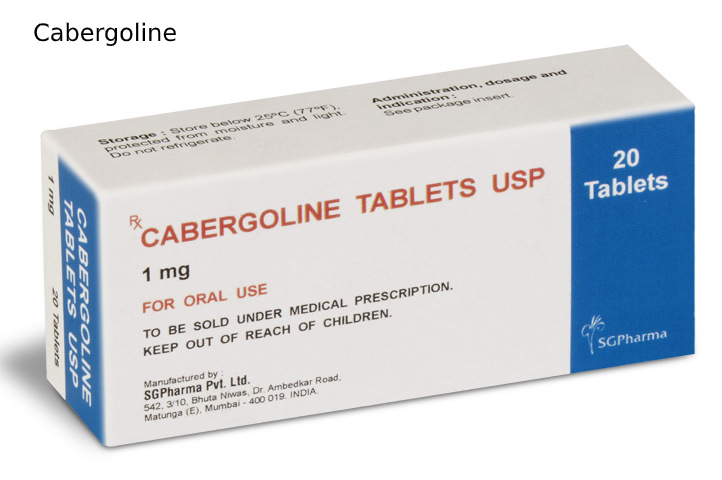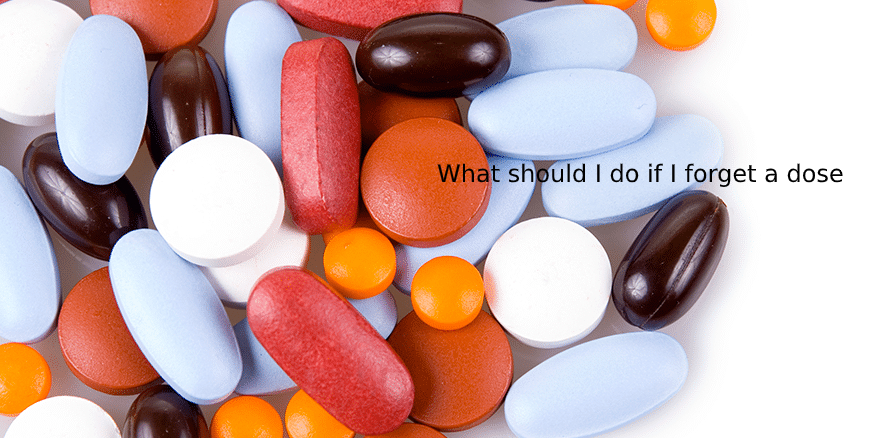Cabergoline

Cabergoline is a synthetic ergoline derivative and a long-acting dopamine receptor agonist with high affinity for the dopamine D2 receptor. Cabergoline exerts an inhibitory effect on prolactin secretion by acting on dopamine receptors present in pituitary lactotrophs. This drug also binds to dopamine D2 receptors in the corpus striatum, thereby mimicking the actions of dopamine on motor control. Cabergoline also possesses antioxidant and neuroprotective properties due to its free radical scavenging activity. Cabergoline is used in the treatment of Parkinson’s disease and in the treatment of hyperprolactinemia.

Cabergoline, sold under the brand name Dostinex among others, is a dopaminergic medication used in the treatment of high prolactin levels, prolactinomas, Parkinson’s disease, and for other indications. It is taken by mouth.
Cabergoline is an ergot derivative and a potent dopamine D2 receptor agonist.
Cabergoline was patented in 1980 and approved for medical use in 1993.
This medication is used to treat high levels of prolactin hormone in your body. High levels of prolactin in women can cause symptoms such as unwanted breast milk and missed periods and can cause difficulty becoming pregnant. High levels of prolactin in men can cause symptoms such as enlarged breasts and decreased sexual ability/desire. Cabergoline is an ergot medication and works by blocking the release of prolactin from the pituitary gland.
Pharmacology
Cabergoline stimulates centrally-located dopaminergic receptors resulting in a number of pharmacologic effects. Five dopamine receptor types from two dopaminergic subfamilies have been identified. The dopaminergic D1 receptor subfamily consists of D1 and D5 subreceptors, which are associated with dyskinesias. The dopaminergic D2 receptor subfamily consists of D2, D3 and D4 subreceptors, which are associated with improvement of symptoms of movement disorders. Thus, agonist activity specific for D2 subfamily receptors, primarily D2 and D3 receptor subtypes, are the primary targets of dopaminergic antiparkinsonian agents. It is thought that postsynaptic D2 stimulation is primarily responsible for the antiparkinsonian effect of dopamine agonists, while presynaptic D2 stimulation confers neuroprotective effects. This semisynthetic ergot derivative exhibits potent agonist activity on dopamine D2– and D3-receptors. It also exhibits: agonist activity (in order of decreasing binding affinities) on 5-hydroxytryptamine (5-HT)2B, 5-HT2A, 5-HT1D, dopamine D4, 5-HT1A, dopamine D1, 5-HT1B and 5-HT2C receptors and antagonist activity on α2B, α2A, and α2C receptors. Parkinsonian Syndrome manifests when approximately 80% of dopaminergic activity in the nigrostriatal pathway of the brain is lost. As this striatum is involved in modulating the intensity of coordinated muscle activity (e.g. movement, balance, walking), loss of activity may result in dystonia (acute muscle contraction), Parkinsonism (including symptoms of bradykinesia, tremor, rigidity, and flattened affect), akathesia (inner restlessness), tardive dyskinesia (involuntary muscle movements usually associated with long-term loss of dopaminergic activity), and neuroleptic malignant syndrome, which manifests when complete blockage of nigrostriatal dopamine occurs. High dopaminergic activity in the mesolimbic pathway of the brain causes hallucinations and delusions; these side effects of dopamine agonists are manifestations seen in patients with schizophrenia who have overractivity in this area of the brain. The hallucinogenic side effects of dopamine agonists may also be due to 5-HT2A agonism. The tuberoinfundibular pathway of the brain originates in the hypothalamus and terminates in the pituitary gland. In this pathway, dopamine inhibits lactotrophs in anterior pituitary from secreting prolactin. Increased dopaminergic activity in the tuberoinfundibular pathway inhibits prolactin secretion.
Why is this medication prescribed?
Cabergoline is used to treat hyperprolactinemia (high levels of prolactin, a natural substance that helps breast-feeding women produce milk but can cause symptoms such as infertility, sexual problems, and bone loss in women who are not breast-feeding or men). Cabergoline is in a class of medications called dopamine receptor agonists. It works by decreasing the amount of prolactin in the body.
How should this medicine be used?
Cabergoline comes as a tablet to take by mouth. It is usually taken with or without food two times a week. Follow the directions on your prescription label carefully, and ask your doctor or pharmacist to explain any part you do not understand. Take cabergoline exactly as directed. Do not take more or less of it or take it more often than prescribed by your doctor.
Your doctor will probably start you on a low dose of cabergoline and gradually increase your dose, not more often than once every 4 weeks.
Do not stop taking cabergoline without talking to your doctor. Your doctor will probably decrease your dose gradually.
Other uses for this medicine
Cabergoline is also sometimes used to treat Parkinson’s disease (a disorder of the nervous system that causes difficulties with movement, muscle control, and balance). Talk to your doctor about the risks of using this medication for your condition.
What special precautions should I follow?
Before taking cabergoline,
- tell your doctor and pharmacist if you are allergic to cabergoline, ergot medications such as bromocriptine (Parlodel); dihydroergotamine (D.H.E. 45, Migranal), ergoloid mesylates (Hydergine), ergotamine (in Cafergot, in Ergomar), methylergonovine (Methergine), methysergide (Sansert), and pergolide (Permax); any other medications, or any of the ingredients in cabergoline tablets. Ask your pharmacist for a list of the ingredients.
- tell your doctor and pharmacist what other prescription and nonprescription medications, vitamins, nutritional supplements, and herbal products you are taking or plan to take. Be sure to mention any of the following: antihistamines; ergot medications such as dihydroergotamine (D.H.E. 45, Migranal), ergotamine (in Cafergot, in Ergomar), and methylergonovine (Methergine); haloperidol (Haldol); levodopa (in Parcopa, Sinemet, and Stalevo); medications for high blood pressure, mental illness, or nausea; metoclopramide (Reglan); or thiothixene (Navane). Your doctor may need to change the doses of your medications or monitor you carefully for side effects.
- tell your doctor if you use or have ever used street drugs and if you have or have ever had high blood pressure or any condition that causes thickening or scarring in your lungs, heart, or abdomen. Also tell your doctor if you have or have ever had heart valve disease. Your doctor will examine you and will order tests to see if your heart valves are healthy. Your doctor may tell you not to take cabergoline if you have signs of heart valve disease or any of these conditions.
- tell your doctor if you have or have ever had liver disease.
- tell your doctor if you are pregnant or plan to become pregnant. If you become pregnant while taking cabergoline, call your doctor.
- tell your doctor if you are breast-feeding or plan to breast-feed. Cabergoline may slow or stop the production of breast-milk.
- you should know that cabergoline may cause dizziness, lightheadedness, and fainting when you get up too quickly from a lying position. This is more common when you first start taking cabergoline. To avoid this problem, get out of bed slowly, resting your feet on the floor for a few minutes before standing up.
- you should know that some people treated with cabergoline have developed gambling problems or other intense urges or behaviors that were compulsive or unusual for them, such as increased sexual urges or behaviors. There is not enough information to tell whether the people developed these problems because they took the medication or for other reasons. Call your doctor if you have an urge to gamble that is difficult to control, you have intense urges, or you are unable to control your behavior. Tell your family members about this risk so that they can call the doctor even if you do not realize that your gambling or any other intense urges or unusual behaviors have become a problem.
What should I do if I forget a dose?

Take the missed dose as soon as you remember it. However, if it is almost time for the next dose, skip the missed dose and continue your regular dosing schedule. Do not take a double dose to make up for a missed one.
What side effects can this medication cause?
Cabergoline may cause side effects. Tell your doctor if any of these symptoms are severe or do not go away:
- nausea
- vomiting
- heartburn
- constipation
- tiredness
- dizziness
- breast pain
- painful menstrual periods
- burning, numbness, or tingling in the arms, hands, legs, or feet
Some side effects can be serious. If you experience any of these symptoms, call your doctor immediately or get emergency medical help:
- shortness of breath
- difficulty breathing when lying down
- cough
- chest pain
- swelling of the hands, feet, ankles, or lower legs
- decrease in urination
- pain in the back, side, or groin
- lumps or pain in the stomach area
- abnormal vision
Cabergoline may cause other side effects. Call your doctor if you have any unusual problems while taking this medication.
What should I know about storage and disposal of this medication?
Keep this medication in the container it came in, tightly closed, and out of reach of children. Store it at room temperature and away from excess heat and moisture (not in the bathroom).
Unneeded medications should be disposed of in special ways to ensure that pets, children, and other people cannot consume them. However, you should not flush this medication down the toilet. Instead, the best way to dispose of your medication is through a medicine take-back program. Talk to your pharmacist or contact your local garbage/recycling department to learn about take-back programs in your community. See the FDA’s Safe Disposal of Medicines website for more information if you do not have access to a take-back program.
It is important to keep all medication out of sight and reach of children as many containers (such as weekly pill minders and those for eye drops, creams, patches, and inhalers) are not child-resistant and young children can open them easily. To protect young children from poisoning, always lock safety caps and immediately place the medication in a safe location – one that is up and away and out of their sight and reach.
In case of emergency/overdose
Symptoms of overdose may include the following:
- stuffy nose
- fainting
- hallucinations (seeing things or hearing voices that do not exist)
What other information should I know?

Keep all appointments with your doctor and the laboratory. Your doctor will order certain lab tests and other tests to check your body’s response to cabergoline.
Do not let anyone else take your medication. Ask your pharmacist any questions you have about refilling your prescription.
It is important for you to keep a written list of all of the prescription and nonprescription (over-the-counter) medicines you are taking, as well as any products such as vitamins, minerals, or other dietary supplements. You should bring this list with you each time you visit a doctor or if you are admitted to a hospital. It is also important information to carry with you in case of emergencies.